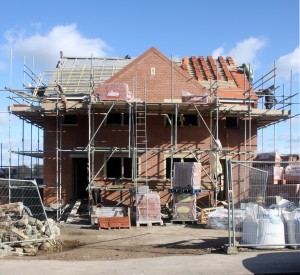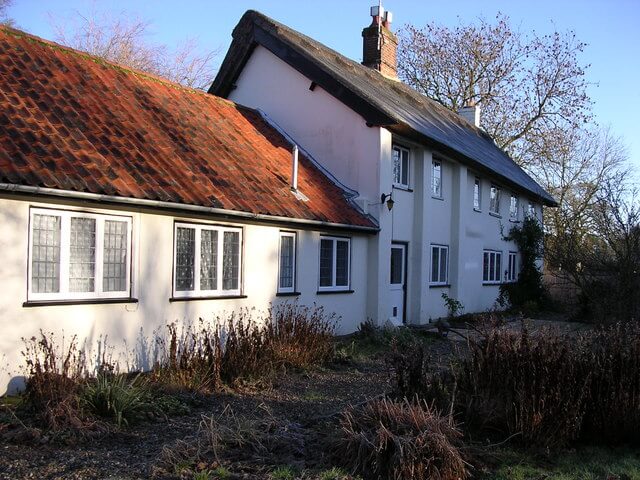How Much Does a Home Office Add to a House?
As so many people were forced to work from home during the pandemic, the existence of home offices multiplied greatly.
Although working from home was on the rise anyway before the pandemic, its existence in homes accelerated enormously during the last two years. With nearly half of all working people in the UK working from home in 2021, home offices have become a staple of today’s houses.
With the ability to have a stable internet connection anywhere in the world and the existence of top quality team communication software and collaboration tools, you do not need to be in the same office anymore to communicate as a team effectively.
That is why building a home office is becoming more popular with more people than ever before. Whether turning a spare bedroom into a dedicated office, renovating the garage or changing the garden shed, home offices can be built anywhere; easily and effectively and for a potentially reasonable cost.
Not only do home offices save your sanity whilst all the family are in the house together, they can have long-term benefits to the resale value of your home.
Does a Home Office Add Value to A House?
On average adding a home office to your house can increase the sale on price of your house by 5-10%. There are other home improvements too, which can add different levels of value to a house, including:
- Loft conversions
- Redecorating
- Double glazing
- Landscape gardening
- Home insulation
The amount that a home office, much like other home improvements and renovations adds to your house depends on the location of the office space, the amount of resources you dedicate to it and how it fits in with the rest of the house.
Why Does a Home Office Add Value?
A home office can feasibly add value to your house because it provides a dedicated work space for the new owners to use for their office.
Although many people are still working from home for the majority of the time, new home owners will not have to dedicate time to creating an office space and instead use the one that you have already built. Alternatively, the home office can be converted into something else, for example, the space can be converted into:
- A home gym
- A utility room
- Storage space
- A guest suite (subject to local planning permission)
Where Should My Home Office Go?
A home office can be built and situated in a variety of different parts of the property which may include:
Spare Bedroom – A common place for home offices to be placed is in a spare bedroom in the house. This, however, will not have much effect, positively or negatively on the value of your house.
This is simply seen as another bedroom regardless of a reconfiguration into a home office and therefore if you want an easy home office rebuild, a spare bedroom is great but it will not add much if anything to the resale value of the house.
Unused Space – Unused spaces within the house are the best places to put your home office if you are looking to add value to the home.
Places such as your loft, your garage or even your conservatory are great places to add a home office. How much this increases your home value depends on a number of factors. However, when looking to sell your property certainly adding a home office as a loft conversion can raise the price of your house up to 8%.
Garden Shed or Extensions – If neither of these options are available then it might be possible to add a home office through outside of the home itself.
One way that you can do this is by converting your garden shed into a home office. Although it may cost a little bit more, having a garden home office can increase your price of property up to 5% allowing you to cover the costs of building it and more. It is always important to check whether you need planning permission in order to do this. You will need permission to build an extension and they can cost a lot just for a home office, but if you need more space an extension is guaranteed to increase the value of your home.
Commercial and Residential Properties - What Can I Use them For?
In the UK, the two main classifications of property for buyers and investors across the country are commercial and residential. Both property types are distinctly classified by way of building regulations, planning permission and intended uses, all of which are useful to know before investing, buying or leasing the property in question.
Any property investment can seem daunting from the outset, but the more informed an investor is as they enter the negotiations, prior to exchanging contracts and completing, he better position they will be in once they receive the keys to the property in question.
Commercial properties are those that must be used for business [commercial] purposes of various natures which can range from a run-of-the-mill office space to a laser hair removal clinic or a shop; whereas residential properties are solely intended to be a place of residence and a place of abode for the property owner or tenants who rent from the owner.
When it comes to landlords, there are some grey areas which need to be considered as a residential property may be intended for the buy-to-let market and thus, there will be a degree of crossover.
What Can Commercial Properties Be Used For?
Before identifying the precise use of a commercial property, the location of the property in question is likely to be an important factor. For example, if the premises are to be used as a high street shop, it will of course need to be situated somewhere near the high street with good foot fall.
However, if the property is to be used as an office and workplace, it may be less important how close it is to high street retailers and more important how close it is to transport hubs in the area for the inevitable employees and staff. Once the location of the business premises has been established, it needs to be confirmed what the property will be used for and thus, if it is permitted to be used in the intended manner. Common uses for commercial premises include:
- Office spaces
- Shops
- Restaurants and cafés
- Showrooms
- Warehouses
There are some permitted uses for commercial premises which will need additional considerations. For example, if a warehouse will be storing hazardous materials or anything requiring additional safety measures, you will need to consider additional regulations and safety precautions prior to being able to commit to the space.

Using Residential Properties
Residential properties will typically be used as the place of abode and residence for a person, family or multiple tenants.
Generally speaking, a residential property will come in the form of a house or apartment. In the case of apartments for residential use there are various forms to consider. These include:
- House conversions
- Apartment blocks
- Maisonettes
- Houses of Multiple Occupancy
Each of which will require different procedures to be followed when buying or letting.
Unlike commercial properties where building work and development will typically require specific planning permission and potentially liaising with the local council or authority, residential properties’ refurbishments will often fall into the remit of permitted development and will therefore not require any specific planning permissions, unless the work falls outside of the remit of such permissions.
Many homeowners will factor into their mortgage, any works they wish to carry out on the property, for example, if a loft conversion or general refurbishment and refitting is required. However, where the works are not fully covered by the mortgage, a short term loan may be taken out or a property loan specifically for the intended works may be taken.
As a landlord, if you are looking to convert a large house to a house of multiple occupancy (HMO) however, you will need to seek planning permission and will need to liaise with the local council, as the intended use of the property will be altered.
Although an HMO will still be a place of abode, albeit for multiple people, the use of the property will be altered from a single to a multiple occupancy residence.
In addition, the landlord and property owner will be responsible for ensuring the necessary and required acoustic testing, such as sound insulation testing is accounted for and carried out prior to the property being inhabited.
Why is Property Insulation so Important?
Home insulation is not a new concept in the UK, although it has had somewhat of a resurgence in the last few years This has culminated in the UK Government’s recent rolling out of their Green Homes Grant (more information), which provides homeowners and landlords with funding to make their properties greener and more energy efficient.
The responsibility for insulating and properly caring for properties in this way falls on whoever owns the property and therefore tenants and residents who have a landlord or management company will need to discuss improvements to insulation with the relevant, managing party.

How Does It All Work?
The process of insulating a property and making it more energy efficient is fairly simple and there are a number of ways in which it can be achieved, with the most popular methods being:
- Installing a new boiler
- Installing double glazing
- Loft insulation
- Cavity wall insulation
- Under-floor insulation
Installing a New Boiler
Older boilers are not as efficient as newer models, which utilise gas more efficiently. As boilers age, they also tend to run in to various problems (particularly when they are not properly serviced over the years) such as fan and motor problems and components of the boiler becoming aged and overused. Although it is entirely possible to keep boilers running for many decades, as time goes on, the boiler is more likely to use more gas less efficiently, being worse for the environment and your bills.
Installing Double Glazing
A tried and tested method for improving energy efficiency and improving the integrity of the building in question’s envelope (the barrier that separates the inside and outside environments.) The better the protection between the interior and exterior environments, the better heat will be retained in the cooler months and cooler air maintained in the hotter months. Also, double glazing will help keep the property at a more stable temperature, putting less strain on the heating and therefore boiler.
Loft Insulation
The loft or attic of a property is usually where much of the heat is lost from the property in question. Heat rises and therefore it is logical that the highest point of the property [the loft] ill be where a large amount of heat is lost. Insulating the loft and attic means that less heat will be lost and will be contained within your property, allowing for less work being required by the central heating and boiler.
Cavity Wall Insulation
In the case of many early 20th Century properties, there is a gap [cavity] between the interior wall of the property and the exterior wall. This was designed so that the elements outside such as the rain and moisture cannot penetrate into the property. However, a major drawback of these designs of property is that the cavity allows cold air to infiltrate by filling the cavity, the building envelope is better secured and the property will be more energy efficient, greener and better for the environment.
Under-Floor Insulation
Surprising to many people is that the underfloor region of their property is poorly insulated. Underneath the flooring you will have in your property, be it carpet or otherwise, there will be the floorboards and underneath will be the joists, supporting the floor and then usually, a gaping space. this space allows for cold air to penetrate, making the property less energy efficient. Fixing this by insulating this is a great way to improve the energy efficiency and retention of your property.
Does taking out payday loans affect your chances of getting a mortgage?
No, taking out a payday loan does not affect your chance of getting a mortgage. According to different mortgage advisors and brokers that we have confirmed with, most providers consider a payday loan to be like 'any other loan' regardless of the fact that it is commonly used by people who are pay cheque to pay cheque.
When applying for a mortgage, you will commonly undergo checks of your credit history and affordability - and this will include looking at any previous credit cards, personal loans and bills that you have had and how well you have repaid them.
Many applicants worry that having a payday loan in the past will affect them for future mortgages and bridging loans - but this is not the case.
What is a payday loan?
A payday loan refers to borrowing a few hundred pounds (around £100 to £1000) and receiving the money upfront, and repaying in full on your next payday. It is often used by people who cannot wait until their next payday to pay for something and need the money upfront. It is best suited for emergencies, including:
- Car repairs
- Household bills
- Medical bills
However, payday loans are also often abused for shopping and gifts.

Around 5.4 million payday loans online were issued in the last year in the UK by around 40 lenders, according to the FCA.
Note that the number of active payday lenders in the UK is decreasing rapidly since the number of lenders able to withstand FCA regulation is falling.
Why is a payday loan considered bad for a mortgage?
For some mortgage brokers and lenders, they consider payday loans to be bad for mortgages. This is because such loans are regularly used by people who are behind on their bills and desperate for funds, hence their eligibility for a mortgage should be questioned.
Some lenders will consider, if a person cannot make it until payday, how can they pay for a mortgage and bills every month?
However, rest assured, most mortgage providers look at payday loans as being 'like any other loan' because many will consider that emergencies can occur that can put you behind your payments.
For instance, if you live in rented accommodation and have a large heating bill, have to help out your family or pay for a funeral, borrowing £500 and repaying it back on time should not stop you getting a mortgage and moving up in life.
Some lenders will be stricter than others
Regrettably, some mortgage lenders will be dismissive of payday loans and people that use them and it may jeopardise your ability to receive a mortgage offer.

However, it is noted that every mortgage lender is different and in this day and age, we live in a world of specialist finance companies. The requirements for someone like NatWest and Barclays is going to be very different to someone like Masthaven and Precise Mortgages.
Depends on what terms - how long ago, did you repay?
Some mortgage companies are willing to look at payday loans on a case-by-case basis. For example, if it was taken out several years ago by the individual and repaid on time, this should not impact your chances of getting a mortgage. Lenders may differ as to whether this is 1 year, 3 year or 5 years ago.
Equally, did the borrower take out one payday loan or are they a habitual user and still owning funds. This will be taken into consideration.
Naturally, lenders are concerned about managing risk and if they determine that an individual cannot afford a mortgage, they will base this on multiple factors and not just payday loans.
How To Use Remortgaging to Release Equity
Many homeowners in the UK are taking advantage of low mortgage rates and through remortgaging, are finding ways to release equity from their homes. According to Remortgage Quotes Online, you can switch your standard variable rate (SVR) from around 4-5% APR to a fixed remortgage rate of 1.3-1.7% during the introductory offer.
The result of record low mortgage rates means that you can potentially borrow more money against your home, whilst keeping your mortgage payments each month roughly the same.
Releasing money through remortgaging is mostly used for:
- Home improvements
- Debt consolidation
- Christmas shopping and presents
- Family holidays
- Gifting to other family members
How Can You Release Equity Through Remortgaging?
To be effective, you will need to have the following:
- Good amount of equity in your home
- Good/fair credit rating
- Good affordability to remortgage
- Stable income (not recent fall)
In order to remortgage, you will need to meet the checks from the mortgage provider, which have become more stringent over the years. They want to seem a strong affordability, which means that your salary is stable or going up (not falling drastically) and your expenses are not going beyond your means.
If you have a poor credit rating since getting your original mortgage, this can impact your chances of getting a new mortgage deal - or you could be stuck on your standard variable rate.
Naturally, to release money from your home, you will need some equity in it, which is achieved by paying off your mortgage on time for several years.
We review some of the options below:
Release Money When You Remortgage
When applying for a remortgage, you can ask to release or borrow money too - and the payments will just be adjusted to your existing mortgage loan. You may have heard the phrase or your parents complain "Well, I will need to remortgage the house for that one." And this is exactly the case.

The more equity you have in your home the better, otherwise releasing through a remortgage with little equity will just increase your monthly payments.
Second Charge Loan or Advance
You can get a 'top-up' when you remortgage, also known as an 'advance' or simply a second charge loan.
In this instance, you are getting an additional loan to your mortgage and this will mean having two loans on different terms. One could be fixed for 5 years and the other could be variable for 2 years. You cannot borrow as much with the second loan as with the first and the amount you can borrow is based on your affordability. Failing to keep up with repayments can have a negative impact on your credit history and cause you to lose equity in your home.
Equity Release
This is only available to homeowners over the age of 55 and this allows you to release equity from your home, and pay off your mortgage at the same time. This is becoming an increasingly popular for the ageing population in the UK and is currently used by around 60,000 households per year, who borrow on average around £80,000.
Through equity release, you are able to receive one large sum amount, upfront, which is completely tax-free. In exchange, you simply give up some equity in your home, which is claimed by the lender when you die or go into long term care. There are monthly interest repayments or you can choose to have an interest only or rolled up interest added to the full outstanding amount. You also benefit from the house increasing in value, which is then used to pay off your outstanding debt.
You can typically borrow around around 25% to 60% of your property's value through a lifetime mortgage, which is a type of equity release product designed to last your lifetime. Or if you want to borrow money, you can use a home reversion scheme to borrow up to 80%, but this will mean physically selling of your home and you will not be able to benefit if it goes up in price in the future.
Ways to diversify your property portfolio
For experienced investors that are already feeling the success of property investment, then you are probably looking to further expand your portfolio to maximise your returns. Through diversifying your property portfolio, you have more scope and opportunity to earn money from multiple sources, not to mention the capital appreciation that can be gained from more than one investment.
A diverse property portfolio can help to mitigate risk by spreading assets across different properties that have a different appeal or draw. Whether this be across different locations, through different types of property, or to have a different target tenants, all properties can help to build and strengthen an existing property portfolio. By following simple tips on how to diversify your property, you can help to keep your assets safer, and your income high.
Consider Studio Living

Studios are a great form of investment which can allow investors to diversify their portfolios with a tighter budget. This type of apartment is an emerging form of living, which has become quickly accepted from the likes of students who wish to live in one modern space whilst still being affordable. Young professionals and students are willing to compromise on space for a better location, and as studios are predominately in city centre locations, the proximity to transport links and universities are appealing for many.
Although small in size, this does not compromise on quality. New developments from property investment companies such as RW Invest offer studio living in the midst of bustling city centres, drawing in tenants due to the fantastic location. As city centre living becomes more and more popular, the demand for studios increases, which will see their value rise significantly and make them a secure investment for strong capital gains.
Look for a lower price point

One of the best ways to diversify your portfolio is to source apartments at both ends of your budget. Invest in those that are low cost and more affordable to attract a type of tenant that is not willing to pay over the odds and secure yourself a higher priced property to catch business professionals and alike that require a higher standard of living.
If you live in an area that is particularly expensive it may be worth looking at other property more further afield. More affordable areas in the UK include:
- Liverpool
- Manchester
- Leeds
These provide a stark contrast to the likes of London which is experiencing escalating prices, therefore hindering investors from investing in the capital city.
Think about different property types

Another strategy you can use is to own different types of property. One example of this is student accommodation, which has become one of the UK’s most popular forms of investment in the UK. High demand through a growing student population and reliable yields create the perfect opportunity for investors.
Commercial property may be another form of property to consider, which will help to expand your investment portfolio. Shops, offices and storage spaces are available for property investors to purchase, whilst still producing stable returns despite being a different type of asset.
Houses of multiple occupancy are another form of investment that is becoming more popular for landlords as quite often they gain more rent from having the same size space. All in all, through having a wide variety of property, investors can give themselves stronger protection from potential risks and as a result generate more income across several different properties.
A Guide on Inheriting a Property
Your property could be the most valuable thing that you own and if you do not have a partner or spouse, it is likely that you will want to pass on your home, flat or properties to your loved ones i.e children. However, what are the implications for someone inheriting the property? Is there tax involved? Do they have to continue making your mortgage repayments? Octagon Capital explains below.
The role of who gets your property falls under the guise of estate planning, which includes things like will writing, funerals and what happens to your estate. When you die, your property and belongings are typically handled by your solicitor that you have instructed and the executor of your will that you have allocated, who will be able to make sure that everyone gets their fair share.

Do I inherit the property immediately?
Yes, although do not worry that things are going to change overnight and you are going to be given heavy bills to pay. Most mortgage lenders are very lenient when it comes to inheriting a property and are willing to offer you a grace period to get everything organised and inheritance tax does not need to be paid for up to 12 months. Until the will is executed and you officially take on ownership, there is no one to collect from anyway.
What can I do with the property that I inherit?
Once the will has been executed, then you own the property and can do with it as you wish including sell it, rent it out or indeed live in it. You may find that you can make a residual income by renting it out to tenants or you may wish to make one lump sum by selling it outright when the market is performing well. You could also hang onto it as a long-term investment if you believe that it will go up even more in price.
In the event that you wish to do any development or refurbishment work on the property, you could look at bridge finance to provide a few hundred thousand pounds over 3 to 24 months. You may find that add an extension or conversion to the property could increase its value by 20% or more, helping you make a better return on the property you have inherited.
Who makes decisions about the property?
As per the will, it is the executor who makes the key decisions about the property and successfully passes it over to the recipient. The executor is usually someone that the deceased person knows but isn't necessarily in the will itself, otherwise it would impact their impartiality. So it could be a solicitor, in-law, friend or colleague. The executor is responsible for the payment of any tax, clearing any debts and distributing the estate to the beneficiaries as outlined in the will.
Do I have to pay the mortgage on a property that I have inherited?
If there is a life insurance policy for the bereaved individual, this can be used to pay off mortgage payments. If there is no life insurance policy or no money allocated, the responsible will lie on the person who has inherited the property to make mortgage repayments each month.
As mentioned above, you are not expected to make payments immediately, you are given a grace period. Of course, if the previous owner owned the property outright, then there is no mortgage and you simply own it 100% with zero payments.
What other costs are there for an inherited property?
In addition to mortgage fees, you may have buildings and contents insurance for any fittings, skirtings and belongings in the house. You need to be insured in the event of a fire, flood, theft or vandalism.
If you are not planning on living there, there are other forms of insurance that can be important such as landlords insurance if you are renting it out to tenants, or if you are leaving it empty, then it is things like unoccupied home insurance and second home insurance.
What tax do I pay on the property?
- Inheritance tax
- Income tax
- Capital gains tax
Inheritance tax
Inheritance tax on a property is huge. If the property is worth less than £325,000, then you are not required to pay anything. Once it is over £325,000, you are required to pay 40% of the value on top.
Income tax
Any revenue you generate from the property from renting it out to tenants is considered to be extra income and is taxable. Depending on how much income you make after costs such as mortgage fees and insurance, the amount of tax you pay will vary depending on the profit you make.
Capital gains tax
If you sell the property, and it has increased in value since you acquired it, you may be required to pay capital gains tax on the difference. This only applies on properties that are not your main residence of living. In some cases, it is better for the inheritor to move into an inherited property immediately, making it their main residence, in order to pay a lower rate of tax.
What to expect when working with a bridging loan broker
Octagon Capital is a broker which is designed to helping you find the best bridge finance for you and your requirements. The main advantage of working with a broker is that you get a full range of products from one place, rather than having to go to each lender separately trying to get the best deal. In addition, the broker only receives a fee if the loan application is successfully funded, so they will be determined to helping you find the best terms and lender most likely to accept your application.
We highlight what you can expect from working with Octagon Capital and similar brokers in the industry.
Phone Call
Once you fill in your details on our homepage or product page, you will receive a call back from someone in the SPF Short Term Finance team. This is our partner who are one of the most established mortgage brokers in the UK.

A team member will call you back to confirm a few details and understand your requirements better, so that we can be in the best position to place you with the lender who is most likely to successfully approve your loan application and deliver the terms you require.
Initial Application Form
Provided that your phone call with our staff member was successful and we can help you proceed, you will need to complete a short application form which requires you to fill in some basic details including:
- Name
- Occupation
- Loan purpose
- Loan amount and term
- Address (both current and address of property)
- Any other relevant information about your existing and future property
This information gives us an essential overview of your requirements and acts as a foundation for the loan that you wish to apply for. Assuming this meets the criteria of our initial lenders, we will pass this onto the next stage.
Indicate Quote
Your loan application will be put through a filter and returned with a number of indicative quotes from the lenders that we work with. Each lender has their own criteria and amount that they will allow you to borrow and the rate they charge. As a bridging loans broker, we can formulate this quickly and you will be given a quick overview of the loan amount and rates. Here is an example below:
Masthaven 80% LTV - £400,000 - 15 months
MT Finance 70% LTV - £350,000 - 14 months
Precise Mortgages 70% LTV - £350,000 - 8 months
Roma Finance 70% LTV - £350,000 - 7 months
As a borrower, you can decide which lender you would like to pursue or all of them in fact. You can then get your paperwork ready in order to proceed.
How to Proceed
The next step before we proceed is always a valuation of the property which determines how much it is worth according to today's market. The cost of a survey will depend on the size of the property, ranging from £300 to £1,200 to larger, more complex builds. The survey is always carried out by a RICS qualified surveyor and can typically be arranged within 2-4 days of enquiring.

The property's valuation is essential to ensure that it stacks up with the figures that you have provided and this may coincide with what the lenders have offered or cause them to change their loan offers.
Assuming everything is good to proceed, you are in a position to introduce your solicitors to the lender and allow the parties to liaise. To be approved for a bridging loan, you will need to provide additional proof of identity to the lender including your:
- photographic identification
- two proofs of current address (of over 3 months) such as a gas bill and council tax bil
Your solicitor will then prepare the mortgage deed and whilst some bridging applications can take a few weeks, there are many which can be arranged in just a few days.
What Fees You Can Expect
As a customer working with a bridging loan broker, it is important to know what other fees to expect with your application:
Broker fees: Depending on the broker that you use and the lender, there is a broker fee of 1% or 2% of the total loan value. For a loan of £500,000, this will therefore come to £5,000 to £10,000. This might seem like an additional cost of working with a broker, however, the broker may also help you get a lower interest rate and better chance of approval earlier on - so you may save money overall.
Arrangement fees: A lender typically charges arrangement fees which relate to the organising of the loan, the work of their solicitors and their administration. The cost of this is typically also around 1% to 2% and depending on the lender, may be a requirement before the loan is funded or it is rolled up into the full loan amount.
Valuation fees: The surveyor you use or is allocated to you will charge around £300 to £1,200 for carrying out a survey of the property. You can use your own surveyor provided that they are RICS qualified, however, a lot of bridging lenders will typically provide a surveyor for you.
Solicitor fees: Naturally, your solicitor is very involved with arranging the mortgage deed and receiving the funds from the loan. You will therefore have to incorporate your solicitor's fees into the mix and obviously having an expensive professional may impact the margins and your return on investment.
Early repayment fees: Bridging loans typically come with early repayment fees, with higher penalties in place if you want to end the loan agreement within the first few months. With this in mind, you need to weigh up the costs of repaying early or letting it run for a few more months and paying the interest.
The Real Benefits Of Becoming A Buy-To-Let Landlord
The number of completed buy-to-let mortgages in London rose by 8.97% in Q2 of 2018, according to Commercial Trust. This is great news for the market as lending for buy-to-let properties previously shrunk by 10%. And it’s not just London which has seen a growth, as the North-West has also seen a jump, taking an 11.11% share during Q2.
Therefore, if you're looking to buy a property, it's worth considering the rental potential of it as there are some great benefits in buying-to-let, including being able to utilize a bridging loan to fuel your new business venture.

Anyone can do it
One of the best things about buy-to-let mortgages is that anyone can obtain them. If you’re an existing homeowner or a first-time buyer, purchasing a property for rental purposes is a great way to make an additional income. Self Certification buy-to-let mortgages allow individuals, such as homemakers or those on a low income to benefit from obtaining and renting out property.
Some buy-to-let landlords even manage to replace their earnings with the profit they make from their portfolios. And, if you do require financial help to refurbish your new property before renting it out, be sure to consider a bridging loan to assist you with your requirements.
Pay off your mortgage and have cash left over
Research conducted by Halifax reveals that the average monthly mortgage repayment is £669. Meanwhile, the BBC reports that the average monthly rental cost in England and Wales is £926. Therefore, buy-to-let landlords benefit by paying off their mortgage and having a significant sum of cash leftover to do with as they please each month. As a result, these additional funds can be used to help you pay back your bridging loan.
Investment opportunities throughout the UK
Traditionally, landlords would purchase properties to rent out close to home as this would give them optimum control of the property. However, investment opportunities are available throughout the UK, with some areas providing greater financial benefit.
Typically, house prices in London and in Southern England are higher than up north. And, with a 3% stamp duty surcharge for landlords owning more than one property, as well as the revelation that the autumn budget will hike stamp duty up further, profits will be hampered, making it difficult to pay back your bridging loan. But, by buying further north and allowing your letting agent to take over the day to day running of your buy-to-let property, your stress levels and your bank balance will be boosted.
Tax relief
There are numerous ways to save on your tax bills as a buy-to-let landlord. Following the announcement in 2015 that tax relief on rental properties was being overhauled, an increasing number of landlords moved their portfolio of properties into a company to lower their taxes. Moreover, buy-to-let landlords can offset costs against tax, including letting agents’ fees, mortgage interest payments, advertising and repair bills, all of which can help you pay back any outstanding financial agreements.
Buy-to-let landlords can benefit in many ways by investing in property for rental purposes. One of the biggest pros is that almost anyone can do it and there’s a significant amount of profit to be made. Furthermore, investment opportunities are available throughout the UK and there are various ways to save on tax, too.
The Insurance You Need For a Building Project
If you are running a building project, having the right insurance is essential to protect you from any potential mishaps. You can never be certain if your property will be victim of a flood, fire or fly tipping and the financial repercussions could put your entire project at risk.
Whether it is for buy-to-let or renovating an existing property, you need proper insurance to safeguard your investment and some bridging loans will not even go ahead until you have insurance in place. We highlight the main types of insurance you may need below.
Buildings Insurance

Buildings insurance comes under the form of home insurance and is used to help protect any damage to physical aspects of the building. This includes covering doors, walls, fences, roofs, ceilings and floors. It is designed to protect you from any accidental or unintended damage to physical fixtures of the property, which could be as a result of fire, flooding, vandalism or other peril.
With builders, plumbers and electricians likely to be working on your project every day and using heavy machinery, you never know when something could go wrong. Whether it is faulty wiring or poor plumbing, it is not uncommon for a fire or flood to occur.
To claim from your home insurance policy, there needs to be proof that any damage caused was a genuine accident. Insurers will always do a full inspection of the property and damage before paying out a claim.
Contents Insurance
Contents insurance also falls under your home insurance so policyholders are likely to have a buildings and contents insurance in one policy. Contents refers to physical valuable items that are in the house or flat. This includes any machines, electronics, art, jewellery and other valuable assets. If the place is a complete building site, then most of the contents will not be on the site. But, if you are working on a property where other people are still living and all their goods are still on the premises, then having contents insurance is key in case anything gets lost, damaged or stolen.
For contents Insurance, it is advised to value all your items that you are leaving in your house like the computer, jewellery and TV and take out a policy to cover their value. It is worth slightly over-insuring so that your insurance provider will pay out enough to replace your items. Insurers will typically only pay out what the goods were worth at the time. So if your TV is 5 years old and has fallen in value, you may not receive enough to replace it - hence taking out a little extra cover can be useful.
Public Liability Insurance
Public liability aims to protect any third parties that come into contact with your building project. When you are renovating a property, you are also potentially impacting people around you including neighbours, passers-by or other tenants of the building.
There are plenty scenarios where public liability insurance can be applied. A common one is if your builders are working on the roof and something like a tile falls off and hits the neighbour’s car or hits a pedestrian walking past. The victim has a right to claim damages because you (or your team) were responsible for this. At this point, you would claim on your public liability insurance in order to settle the victim for any replacements, medical bills or compensation.
Other scenarios include what would happen if your building work accidentally set fire to the neighbour's house? Or what if your boiler broke and then flooded other tenants in the building? This types of damages and repairs could be covered by your insurance.
Business Interruption Insurance
Business interruption refers to any costs that you have to incur due your project being interrupted. Perhaps you are working on a deadline or you will need to refinance due to the project taking longer than expected. Whether it is a fire, flood, snow, fly tipping or squatters on your premises, there are several things that could make your project delayed. After all, we all know that building work can take longer than we expect.
Rather than suffer the financial burden, your business interrupted insurance can contribute to any additional costs you may have whether it is building costs, loss of rent income or extra costs required to repay your loan.
Professional Indemnity Insurance
Professional indemnity or PI, is less for you but more the people that you hire. Any professions such as builders, architects, plumbers and engineers are using their expertise when working on your building. However, if they give you bad advice or carry out their work poorly, it could have a huge impact on the overall success of your project and the bottom line.
As a result, you may decide that you wish to take legal action and request compensation for any loss of income or delays in your project. Your potential settlements will come out of the contractor's professional indemnity insurance. So it is a common thing to ask any professionals that you work with beforehand if they have PI cover.
Employers Liability Insurance
Of all the insurance types mentioned above, employer's liability is the only one which is required by law. This is cover for any employees that are working on your premises. They must be your own staff that you hire because any staff belonging to your contractors must go under their own separate policy. Failing to show proof of employer’s liability insurance upon request or a certificate can lead to a minimum daily fine of £2,500 and further prosecution.
The idea of employer's liability is that you have a duty of care for any of your staff members and are responsible if they have an accident at work. Working on a building site poses risks, especially with different materials and obstacles that could cause injury. If one of your people gets injured at work, you can claim on your policy in order to pay for any medical bills, compensation or time off work.
You are required to have a minimum of £5 million worth of cover by law of which a policy may only be a few hundred pounds to purchase. The only exceptions are if you run a family business, you are not required to purchase employer's liability cover for your own family members. Also, any freelancers, sole traders or consultants are required to insure themselves and this is not your responsibility.
How Much Does Insurance Cost?
The cost of insurance will vary on the size of your overall project. Naturally, the refurbishment of a large property which is being changed into 12 rooms will require more staff, budget and insurance than the renovation of a small 2-bed home.
Whilst insurance can easily start from a few hundred or thousand pounds, it is important to cost up the potential risks and what the cost of any damages will be. Using a good insurance provider will help you better understand any risks and levels of cover that you need and it is important to speak to your partners and contractors to ensure that you are all fully covered to carry out the necessary work.








